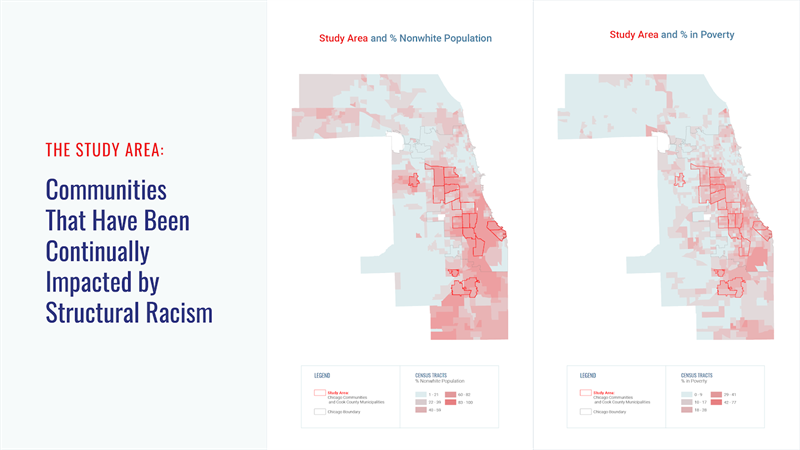If anything has become clear from the COVID-19 pandemic, it is that the fate of all communities are connected. Data transparency and a shared understanding of disinvestment (and structural racism) are crucial to make future investments more equitable

It became clear early on during the pandemic that COVID-19 was having devastating impacts on Black and Latinx populations across the Chicago region. By now, it should not be a mystery that these disparate impacts result from longstanding structural conditions. They were created and reinforced by public policies and patterns of investment and disinvestment, rather than by health choices or behaviors. It is the same diagnosis that we also find for many of our biggest challenges, whether it be neighborhood violence, mental health challenges, environmental justice, or some other future health crisis. Longstanding inequalities can be thought of as a tinderbox, and COVID-19 was just the latest match to ignite this tinderbox, with devastating results for BIPOC communities.

But the pandemic has taught us that the fates of all communities are connected — if one of us is sick, all of us are potentially sick. With this in mind, 2020 has witnessed a growing movement in Chicago to standardize data about where investments are going — philanthropic investments, public investments, private sector investments — and a pledge to shift resources more to BIPOC communities and BIPOC-led organizations. A group of philanthropic stakeholders and researchers led by Angelique Power and the Field Foundation worked collaboratively throughout the past months to develop a shared analytic framework, and to push for more data transparency. This effort has resulted in more than 20 foundations, numerous public agencies, and a few private sector entities sharing data about how investments have been shifting to respond to the pandemic (a full list of project partners is listed at the bottom of this post and can also be found here). The presentation that was created by this partnership is meant to be shared widely and used by anyone. It can be found here.
Early analyses show some encouraging evidence of more resources flowing to the communities that need them the most. But in order for this trend to be a sustainable movement and not just a COVID-19 response, more partners need to sign-on and pledge to be a part of the investment paradigm shift. Shared definitions of the problem, shared analysis, and tracking of investments are just a start. Much more work is needed. Below are some highlights from the shared presentation the collaborative created (Graphics were created collaboratively by Mike Stiehl, Chapin Hall; Jennifer Axelrod, Chicago Community Trust; Shawn Kendrick, Chicago Community Trust; Dan Cooper, MPC; and Ann Liu, with invaluable input from all project participants).

Our group used a simple definition for communities that have the greatest need for resources and investments: areas where the population is over 80% nonwhite, where the poverty rate is also over 25%. This definition captures many of our Cook County communities on the South and West Sides of the county (zip codes outlined in red).
These are also many of the same areas that were redlined over half a century ago, resulting in investment and wealth disparities that exist this day (redlined areas appear with light blue boundaries. Private sector investment is shaded in red. Areas with the most investment are clustered on the north side and on the county's outer ring). Nearly all of the health and economic challenges we face as a region can be traced to this simple, repetitive investment pattern.
Economic vulnerabilities, created by these investment patterns over time, are what have caused health disparities, and the high rates of pre-existing conditions in many BIPOC communities. Income and wealth are some of the biggest determinants of health, and a lack of income is responsible for high concentrations of people with diabetes (left), and high blood pressure (right).
Once we have created a tinderbox, all it takes is one match to ignite it. COVID-19 is that most recent match. As the map above demonstrates, COVID-19 cases have been disproportionately clustered in many of our communities with large BIPOC populations. The death toll has been devastating for Black populations in particular, and Latinx populations continue to test positive at alarmingly high rates.
Latinx workers are disproportionately "essential," putting themselves at greater risk so many of us can comfortably work from home. And many of these same workers live in areas that lack pharmacies, increasing travel times in order to access essential medication if they are infected with COVID-19.
There are many more similar trends when it comes to structural disadvantage. Ultimately, it boils down to a problem we have failed to solve for decades: investment disparities. If we are going to reverse these trends and eradicate the "tinderbox," all sectors — private, public, and philanthropic — will need to radically shift the ways they invest. Transparency is a crucial first step.
Among the philanthropic partners who signed on to share data about historical investments, we have seen some encouraging progress. The map above (left) shows that, in the year prior to the pandemic, foundations were not funding organizations located in BIPOC communities as much as areas like downtown Chicago. Since the pandemic began, it is clear that more dollars are reaching organizations in BIPOC communities (right).
This effort is illustrating that a paradigm shift is possible. How sustainable and how large it becomes depends on more institutions and partners agreeing to be a part of this solution. As we begin to see light at the end of the pandemic tunnel, we must all redouble our efforts to ensure that policies and investments center on historically disinvested areas, otherwise we will find ourselves in this same situation, yet again, during the next health or economic crisis.